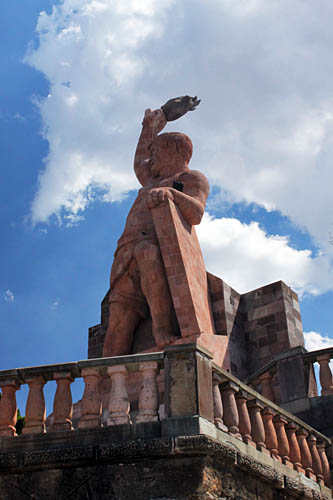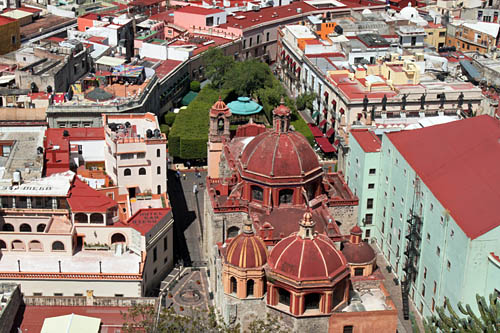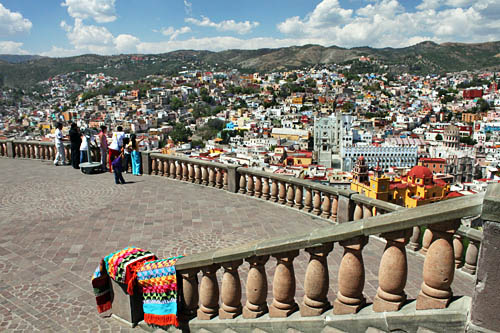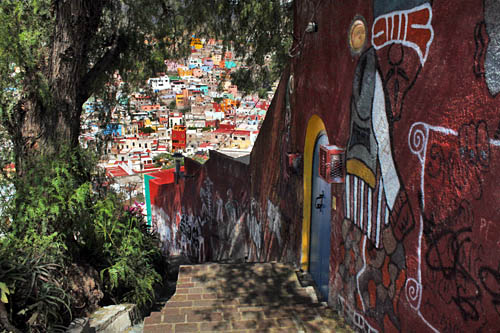From the top of San Miguel Hill, the massive stone monument to Juan José de los Reyes Martínez Amaro gazes serenely over the valley that cradles Guanajuato, Mexico, but back in 1810 this uneducated miner was bent on revenge. Martinez was known by the nickname Pipila, which some claim was a reference to a deformity that caused him to walk like a hen turkey and others say referred to his pockmarked face, which resembled a mottled turkey egg. Further exposing himself to ridicule from his fellow workers, Martinez protected himself from falling debris by wearing a long, flat slab of rock on his back when working inside the mine, but events would soon conspire to turn this transform this simple worker into a hero.

By September 28, 1810, independence sentiments had reached fever pitch in Guanajuato. Incited by the rhetoric of Miguel Hidalgo, a priest from the nearby town of Dolores Hidalgo, Mexicans and indigenous Indians attacked the Spaniards. The Governor, the soldiers under his command, and Spanish civilians living in the city gathered all the riches they could carry and barricaded themselves inside the Alhondiga de Granaditas, a stone granary thought to be invincible.


The insurgents attacked but were repulsed by Spanish musketeers firing from their position high atop the grain tower. Just when things were becoming desperate, Pipila donned his stone slab, crawled to the wooden door of the granary, covered it in pitch, and set it on fire. Once the door of the Alhondiga was breached, the outcome was certain, since the locals severely outnumbered the Spaniards. They massacred everyone inside, earning Guanajuato the title of birthplace of Mexican Independence.
Unlike the real Pipila, who is said to have walked hunched over, the stone monument stands tall and thrusts a giant torch into the air. Easily seen from most places in town, its hulk is often used by tourists to orient themselves on the maze of serpentine streets that make up Guanajuato. Several staircases lead from the bottom of the valley to Pipila but the climb is strenuous. Alternatively, a broad boulevard allows access by auto, but by far most interesting way to reach the top is to ride the funicular. Located just behind the triangular park known as Jardin de la Union, this tiny cog railway car provides sweeping panoramic vistas of the valley as it chugs up narrow, almost vertical tracks.

After climbing the stairway inside Pipila and drinking in the view from torch-level, you can return to town by following the terraced stone platforms to one of several winding stone staircases that afford gorgeous views of the valley, framed by old-growth trees and blooming hedges.

Did you ever go to Durango? You should visit it! It may not be the most beautiful state in México but it’s worth visiting, the food is great!
I would recommend you to visit El Espinazo del Diablo, Mexiquillo, Durango city, and desert zones.
Hi Durango: No, I’ve never visited Durango, but will return some day and do so -thanks so much for the recommendations!
Cinco de Mayo is only celebrated in Puebla, another beautiful colonial World Heritage city where the Battle against the French took place. Wow, I’m so jealous. Guanajuato look beautiful, I think if you liked this city for its little alley way you would probably love Taxco as well.
Great post I like your website and Plz update it a lot more I’ll subscripble you.
I continue to enjoy your reports from Guanajuato, Barbara. Nice video.
Hi Donna: Got some great ones coming up – bet you’ve never seen dancing like what these videos wll feature. But at the moment I’m deep in the jungles of Mexico in the State of Chiapas, where I’m exploring the ruins of Palenque. Working on basically a dial-up cnnection that holds for about 60 seconds at a time. Such fun! But of course I can’t upload videos right now, so stay tuned.
Totally unrelated, but out of curiosity, what was it like being in Mexico on Cinco de Mayo?
Hi Jetpacker: I was also thinking about this whole Cinco de Mayo thing. It’s a low holiday here in Mexico. Dieceseis de Septiembre and Semana Santa are much more popular. I was in Veracruz for Cinco de Mayo and nothing special happened. The normal weekend dancing to a full orchestra was ongoing at the Zocalo, but that happens every weekend of the year. In the U.S., Cinco de Mayo has become pretty much a bar holiday, and I venture to guess that few people even know the significance of the date.
The real name of “El Pípila” was Juan José de los Reyes Martínez Amaro. He received his nickname “El Pípila” from his companions on account of his pockmarked face. The word “pípila” means “turkey egg” in his native language and anyone who is familiar with turkey eggs can tell you that they are mottled and have a rough surface.
Hi Bob: Thank you for that information. As you probably know, it is almost impossible (without spending hours at a library), to get the correct information about historical sites in Mexico. In most cases, there are no printed materials available at the sites themselves, and even the tourism offices are sorely lacking in information. My original statement about him walking like a turkey hen came from Wikipedia, and it was repeated often in my Internet research, though I could not find a translation of the word Pipila. I’ve added your comments to my post. Barbara